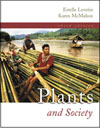
Human Nutrition |  |
Chapter Summary1. The nutritional needs of the human diet can be categorized into the macronutrients (carbohydrates, proteins, lipids) and micronutrients (vitamins and minerals).
2. Carbohydrates include simple sugars, such as the monosaccharides fructose and glucose, and the disaccharides, sucrose and lactose. Complex carbohydrates or polysaccharides include starch and glycogen and fulfill the role as the body’s fuel. Dietary fiber includes both soluble and insoluble forms that provide beneficial health effects acting as roughage, promoting regularity, and lowering blood cholesterol levels.
3. All plant proteins are incomplete, deficient in one or more essential amino acids. But complementing incomplete plant proteins such as combining legumes and cereals in a single meal can overcome this deficiency.
4. Lipids include fats and oils, and most of the dietary lipids are classified as triglycerides. A diet high in saturated fats raises the risk of cardiovascular disease and certain cancers. Unsaturated fats, whether monounsaturated or polyunsaturated, lower the risk of cardiovascular disease by lowering blood cholesterol levels. Foods of animal origin generally are high in saturated fats and cholesterol, but food of plant origin lacks cholesterol and contains mainly unsaturated fats.
5. Deficiency diseases result if a diet lacks any of the essential vitamins and minerals. Fat-soluble vitamins (A, D, E, and K) can be stored by the body but can build up to toxic levels if excessive amounts are taken. Water-soluble vitamins (C and B complex) cannot be stored in appreciable quantities by the body. Most vitamins and minerals (the exception is vitamin B12) can be found in foods of plant origin. The category of minerals (major or trace) is defined by the quantity needed in the body.
6. Americans should modify their diet for a healthier lifestyle. Dietary guidelines suggest that carbohydrates should make up about 60% of the daily caloric intake, proteins about 8%–10%, followed by no more than 30% total fats (10% each saturated, monounsaturated, and polyunsaturated). Increasing the percentage of plant-based foods in the diet, while at the same time decreasing the amount of animal-based foods, can lower the risks of cardiovascular disease and certain cancers.
|
|
|